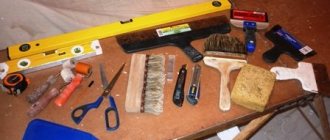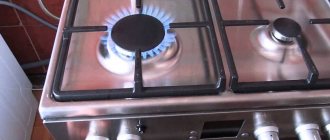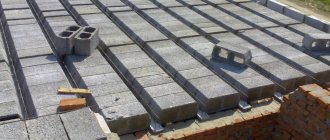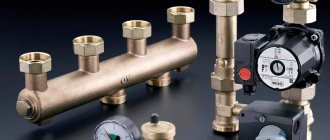Modern gas stoves are equipped with an automatic ignition system. It is very convenient and practical: you can forget about matches and lighters. It is enough to press a special button or, almost like in an electric stove, turn and press the burner knob - and a spark will appear, igniting the gas.
The downside of this convenience is possible breakdowns of the auto-ignition system. Housewives often encounter a problem when the ignition does not turn off: that is, clicks are constantly heard and a spark is visible, even if you do not approach the stove at all.
Note! This problem is typical for gas stoves with an electric ignition system. The piezoelectric element is designed differently, and its malfunctions are not discussed in this article, since all modern household stoves use electric ignition. The piezo ignition system is found only in old Soviet or modern tourist stoves (without connecting to electricity).
Auto-ignition operating principle
To understand the cause of the auto-ignition malfunction, you need to know how it works. It is not difficult to understand the principle of its operation: the ignition mechanism is powered from the electrical network, and it is started by pressing a special button and turning towards the gas supply regulator, in the direction indicated on the arrow shown on the stove panel. The process of operation of this mechanism is as follows:
- When you press the ignition button, the spark is converted due to the flow of electrical impulses.
- When you turn the knob to open a certain burner, gas is supplied to the burner.
- The spark produced when the ignition mechanism is activated interacts with the gas, converting it into fire.
- The burner into which the gas was supplied begins to burn.
You can release the handle a couple of seconds after turning it - that’s exactly the time it takes for the system to magnetize. Of course, in reality, the entire arson process takes place much faster than it is described here. The burner lights up and a spark is supplied to it. The ignition button itself is located on the stove panel, next to the gas supply regulators.
In old-style stoves, the ignition process is slightly different from ignition of gas in new models. Its difference is that a spark is supplied to all burners at once, but only the one whose valve has been turned is ignited.
For both old and new models, for the auto-ignition mechanism to work, it must be connected to the electrical network.
Causes of problems
To troubleshoot problems in which the gas heater clicks but does not ignite, you need to pay attention to the following:
- there is no spark from the piezoelectric element or the igniter does not work;
- the burner is difficult to ignite the first time, and then goes out;
- water regulator is leaking;
- When you turn on the device there is a bang.
In good condition, the device operates silently and operates with a slight delay - no more than 1-2 seconds. Let's consider the main reasons for the clicking of the igniter of a gas water heater.
Piezoelectric element does not produce a spark
If the gas water heater is equipped with piezo ignition, then the following problems may arise with it:
- Errors during operation. The fact is that water heaters have a safety system that controls that the igniter first warms up and only after that can the wick be lit. You must carefully study the instructions and find out how to properly ignite the device.
- There is no spark in the water heater. This is usually caused by a broken piezoelectric element or electrode. In this case, the column will not be able to ignite, and then there is only one solution - to replace the piezoelectric element.
- The wick does not light. The breakdown is associated with failure of the automation or lack of traction. The problem can also be caused by a dirty igniter that needs to be cleaned. A sign is that the wick burns only when gas is forcedly supplied. After it stops, the wick immediately goes out. Cleaning the igniter will help solve the problem.
Replacement of elements should be entrusted only to service center specialists.
No power to igniter
The lack of power to the igniter of a gas water heater powered by a battery or hydro generator is determined by the fact that the device does not start working when the hot water tap is opened. It is necessary to check for the following causes of water heater problems:
- The batteries are dead. A sign of this is that a spark appears, but it cannot ignite the burner. The column does not turn on immediately, but the electric ignition clicks constantly.
- The hydrogenerator - the turbine that produces electric current - does not work. The element is affected by pressure and water. If the hydrogenerator refuses to work, then you need to clear the internal space of sediment and debris. A specialist will help stabilize the pressure in the turbine using pumps.
- Problems in the power supply. Often the reason for the lack of power to an electric water heater is a breakdown of the power supply. It may fail due to disconnection or oxidation of contacts, damage to resistors, etc. If you know how to solder, you can fix certain problems yourself.
Note! Even powerful batteries with frequent use of the water heater last for 6-7 months. Then problems begin to occur during operation.
Lack of ventilation or draft in the chimney
If the gas heater clicks, lights up and goes out, then most likely the problem is the lack of normal draft. Over time, the chimney becomes clogged with soot, leaves or other debris, which should be cleaned out periodically. Also, the quality of ventilation and draft may deteriorate after replacing windows, doors or changing the design of ventilation ducts. It’s very easy to check their influence on the operation of a geyser - if it works well when the window is open, then it’s a ventilation issue. To correct the situation, an additional ventilation system will have to be installed in the room. For example, there are special valves that are installed on plastic windows.
Leaks in the water unit
The gas water heater clicks and ignites late and when there are leaks in the water unit. The following signs will indicate this:
- after turning on the water, the device does not light up immediately;
- the water unit may leak.
The cause of leaks is a torn or deformed diaphragm of the unit. Significant pressure is exerted on it during switching on. As a result, the diaphragm can:
- stretched - then the column is turned on only with strong water pressure, but there will be no leakage;
- tear - as a result, the water heater does not turn on the first time, there is also a leak;
- harden – with very hard water, various deposits accumulate on the diaphragm; as a result, it becomes coarser and operates unclearly.
Lack of optimal water pressure
The instructions for any geyser indicate the minimum water pressure at which it must operate. If the burner clicks and does not light, the reason may be due to insufficient water pressure. The problem can be solved by installing a storage tank and a pump that will increase the pressure in the pipeline.
Why can the electric ignition of a gas stove click?
The causes of this malfunction can be very different, but all of them do not deserve special concern and, as a rule, are easily eliminated:
- If a clicking sound is heard after washing dishes or the stove, then the reason for its appearance is moisture that has entered the electric ignition. It causes the contacts to oxidize and close the circuit.
- Carbon deposits on the ignition button and subsequent sticking of the contact
- Overheating or breakdown of the button, leading to a short circuit of the entire circuit.
- The button malfunctions due to the accumulation of grease or dirt under it.
- Water gets into the auto-ignition switch.
- Violation of the rules for operating the stove.
- Problems associated with the functioning of the electrical panel responsible for supplying electricity to the room.
- No gas supply.
If all of the above reasons do not apply to the situation that has arisen, you should not carry out repairs yourself, since only a specialist can solve the problem in this case.
Basic troubleshooting methods
To eliminate the source of the defect in the work, it is necessary to take action. Namely:
- Eliminate moisture. Due to the salts in the liquid, which, in fact, act as current conductors, the contacts close.
- Disassemble the structure and dry the button.
- Remove the old one and replace it with a new electric ignition.
- Easy cleaning.
- Make sure that only one button does not work; to do this, turn on the next burner; if ignition does not occur, then repair the button.
What to do if the piece constantly clicks on its own
The most important thing in such a situation is to find the source of the problem, and then simply follow the instructions for eliminating it. If you discover a breakdown, do not panic and strictly follow all safety rules, try to make repairs, guided by our advice. Remember - most of the causes of the problem, in this case, are absolutely safe and can be eliminated independently, without resorting to the services of specialists.
How to fix the problem without the help of a specialist
The following actions can help in dealing with the malfunction:
- If the cause of the breakdown is water, and its constant contact with the stove, then there is only one way out - dry it thoroughly, first turning off the auto-ignition from the outlet. Let the stove stand unconnected to the power supply for several days - during this time it should dry thoroughly and the clicking will stop on its own. If such a “repair” does not help, it’s time to call a specialist and entrust the repair to him. When drying, one important point must be taken into account - you cannot dry the stove using a working oven - otherwise moisture, on the contrary, will accumulate in the appliance in huge quantities and the situation will only worsen. Therefore, be patient and let the device dry naturally.
- If the ignition button does not work well, the reason is the accumulation of dirt, dust or congealed grease under it. Clean it. For better cleaning effect, use a brush dipped in soapy water. After cleaning, let the stove dry. It should be noted that this method is not always able to return the button to its previous functionality. There is always a possibility that due to the low landing, it will not press completely. If cleaning does not help, consider replacing the auto-ignition button or its entire mechanism.
During prolonged use, the auto-ignition unit may fail. If only one burner does not work, then the reason is most likely due to damage to the wire located in the channel of the block. But do not forget that the burner itself may also be faulty, and in this situation, independent repair is not only unacceptable, but life-threatening. To accurately diagnose the cause of a non-functioning burner, you should contact a specialist who can not only identify the actual cause of the malfunction, but also replace the damaged element.
The main thing is that no matter what happens to your favorite stove, do not panic and act thoughtfully. Remember, thoughtful repairs can fix almost any damage.
Household appliances Stove
Is it dangerous?
If the electric ignition of your gas stove is constantly clicking, do not worry. This affects only a minimal increase in energy costs and discomfort while in the kitchen. The main and not the best consequence is the accelerated failure of the block and spark plugs. Thus, repairs can be performed not urgently, but at a time convenient for the client. Don't worry and put off important things or work. Call our Workshop and make an appointment at a time convenient for you. The extended work schedule allows you to choose both weekdays and weekends, both morning and late evening.
Is it dangerous?
If the electric ignition of your gas stove is constantly clicking, do not worry. This affects only a minimal increase in energy costs and discomfort while in the kitchen. The main and not the best consequence is the accelerated failure of the block and spark plugs. Thus, repairs can be performed not urgently, but at a time convenient for the client. Don't worry and put off important things or work. Call our Workshop and make an appointment at a time convenient for you. The extended work schedule allows you to choose both weekdays and weekends, both morning and late evening.
Oven thermostat does not regulate flame
Housewives who do not very well understand how the oven thermostat works often complain about this effect. If you have a stove with a thermostat, then when you change the position of the regulator, the flame may not change immediately. The thermostat works like this: first, while the oven is cold, the gas is supplied at full power, no matter how the engine is installed. As it heats up to the desired temperature (this is what is set on the regulator), the valve gradually closes and the flame decreases.
But two other malfunctions may be associated with the thermostat. Firstly
, after heating the oven, the flame may go out.
Secondly
, the flame may burn too hot, despite the fact that the oven has already warmed up. Both of these problems are caused by improper adjustment of the low fuel screw on the oven burner (Figure 3.A).
Figure 3. The faucet handles and the front panel under these faucets have been removed.
This screw needs to be turned out a little. Light the oven and close it. Set the regulator to 140 degrees. Wait 10 minutes. Now, by adjusting the screw, you need to ensure that the flame is small (the tongues are about 4 mm), but burns steadily and does not go out. Usually this is easy. But sometimes, even with the low flow screw fully tightened, the flame is too large. The fact is that there is a small hole in the screw, which prevents the gas supply from being completely blocked even when the screw is screwed in completely. Why this hole is needed, I still haven’t figured out. But the fact remains a fact. If the flame cannot be reduced to the required level, then the screw must be unscrewed completely and replaced with a screw with a smaller hole, or the hole must be sealed with Poxypol (it is absolutely useless). Then screw in the screw again and adjust the flame.
All of the above applies to an oven with a thermostat. The burner with tap is adjusted in the same way as the table burners. It is very easy to distinguish a thermostat from a faucet. Temperature values are written on the thermostat scale. The faucet scale has just numbers.
Problems with burner control knobs
Gas supply handles for the burner are one of the most necessary parts; without them it is impossible to use the stove. Behind the outer skirted flag, which you turn, there is a gas tap, which can have a gas control sensor built into it.
Electric ignition built into the handle is rare on Hephaestus stoves - it is usually located with a separate button.
Over time, the knobs may stop turning, become stuck, or become loose. We'll tell you what to do about it later.
The handle is difficult to press and turn
This problem is not uncommon; if you start it, the handle may stop turning completely. The cause is usually grease that has accumulated between the flag, skirt and front panel of the cooker.
Hot, it splashes during cooking and easily flows into all the cracks, and then cools, thickens and turns into a kind of glue.
Carefully pry up the skirt and handle with a knife, screwdriver or other flat object. Do not use too much force - you may damage the enamel or plastic.
To get rid of the problem, the flag with the skirt must be removed from the stem and washed thoroughly. The handle needs to be pulled towards you - it is simply pressed tightly onto the rod, without latches or other fasteners. For convenience, you can grab it with pliers, preferably through a non-slip cloth, one of those sold for cleaning.
The skirt usually comes off on its own after the handle is removed, but if it does not turn with the flag, it can be secured with a latch. In any case, you can pick it out with a knife. Remember its position so that when assembling, the latches close to the panel or flag.
Many models have a reinforcing metal plate in the handle; do not lose it. After washing all the parts, as well as the front panel under the handle, put everything back in place. Don't forget to install the spring if you had one.
The checkbox scrolls or jumps off
This problem is rare with Hephaestus slabs, but it does happen. The reason is usually that a metal plate has fallen out of the flag and is lost, which clings to the recess on the rod.
You can cut such a plate from a metal preservation lid and insert it into a special groove, or buy a new flag. If the handle on your model is completely plastic and its inside is licked off, only buying a new one will help.
The handle turns hard
It happens that even after the flag and skirt are perfectly washed, the handle still turns tightly. The reason is that the lubricant on the gas taps has run out.
It is better to invite a specialist to carry out preventive maintenance, because mistakes during such repairs can lead to leakage or clogging of gas supply pipes
If you decide to lubricate the gas taps yourself, buy a special graphite lubricant for this. Turn off the gas supply to the stove. Then remove the handles and the front panel - we described how to do this above.
In Hephaestus slabs, the stem is fixed in the tap with a flange connection; to remove it, simply unscrew 2 bolts on the sides. Immediately wash the stem from grease and dust.
Then the spring and the tap plug are removed - the last one needs lubrication. This is a cylindrical part with a through hole and a cut on the side, through which gas is supplied to the burner. You need to lubricate the cork very little; the layer should be invisible, but noticeable to the touch. It is more convenient to put a little lubricant on your finger and rub the plug.
After assembling the faucet, do not rush to replace the front panel. First, put the flag on the stem without it, open the gas and apply a soap solution to the tap. If no bubbles appear anywhere, wipe everything dry and reassemble the stove.
Professional repair of household appliances
When water gets into the gas stove, that is, it ends up inside the system, it is undesirable and dangerous to repair it yourself. You need to call a technician who will examine the burner and other tile elements and, if necessary, perform a “blow-out” to remove moisture. Service specialists will promptly respond to the client’s call. Operators accept applications from 7 am to 11 pm, daily. If you need an urgent visit, contact us before 12:00 and the specialist will arrive on the same day.
Source
Possible consequences
If liquid floods a gas stove burner, the most dangerous consequence is an extinguished flame. If the model is not equipped with a gas control system (or the safety element does not function), this may lead to gas contamination and an explosion. If you find gas turned on without a fire, you must immediately shut off the supply of flammable substances and ensure maximum ventilation of the room. If the owner floods the gas stove with water, common malfunctions:
- Failure of the electrical ignition - it is necessary to check the contacts and electronic components (a task for a specialist). Contact shorting usually disappears after the moisture dries. If the auto-ignition unit gets wet, it will have to be replaced entirely.
- Nozzles are clogged (the burner does not burn, or the combustion is weak and unstable) - the burner is dismantled, the nozzle hole is carefully cleaned with a thin object (for example, a needle). If you find strong obstacles that cannot be removed without much effort, it is better to contact a specialist.
- The appearance of soot from the burners. This is caused by pollution and blockages resulting from flooding. It is enough to remove the blockage and check the condition of the flame diffuser.
- There are many reasons for a decrease in pressure, including liquid in the gas supply system.
- Failure of the thermocouple or solenoid valve will require replacement.
Corrosion is unlikely because the surfaces in contact with the liquid are enameled.
Conclusions and useful video on the topic
The first video contains information that will help you understand some of the causes of current leakage and understand how to deal with them:
The following video shows how you can independently detect the presence of a current leak:
The presence of a discharge on the body of the gas stove indicates that it is faulty or there are problems in the electrical network. The situation is complicated by the fact that “blue” fuel is flammable and explosive. Therefore, operation of the stove should be stopped immediately after the first signs of malfunction are identified. This will prevent accidents.
Your stove also recently experienced an electric shock, but did you successfully deal with this problem? Share your experience with other users, tell us what the problem was and how you managed to fix it - the comment form is located below this publication.
Prevention measures
Regular preventive maintenance of the device will help to avoid breakdowns and prolong the operation of the oven. Follow the operating instructions for the equipment. Follow the cooking technologies for different dishes and the recommended temperatures for them. View the design of various oven components. Recommendations for washing and lubricating elements are also important.
After finishing the baking or stewing process, always keep the walls and bottom clean, this will help improve the functioning of the appliance. Remove dirt and food debris. This will prevent the internal parts of the oven from becoming clogged and damaged. Use high-quality household chemicals for washing. Cheap powdered products scratch the glass of the door, destroy the enamel, and make the seal hard.
Ovens are considered reliable appliances. If the device breaks down, specialist help is not always required. Some problems can easily be fixed with your own hands. For example, cleaning individual elements, replacing regulators, seals, heating coils, adjusting the oven door and thermocouple. When you cannot find the cause of the breakdown, you cannot do without calling a service center employee. Usually problems can be solved, and repairs do not take much time.
To learn how to repair an oven in a gas stove, see the following video.
Conclusions and useful video on the topic
A video about how to troubleshoot a geyser. A detailed overview of disassembling and repairing a gas water heater at home:
In case of any type of malfunction, as a result of which the gas water heater hums and crackles, you can try to fix the breakdown yourself. But there is no guarantee that you will not damage the device. Therefore, the best option would be to contact a specialist for servicing your gas water heater.
.
Would you like to supplement our material with useful information on eliminating the causes of excessive noise and crackling noise from a gas water heater? Or would you like to clarify a couple of diagnostic points? Ask your questions to our experts, leave comments, participate in the discussion - the feedback form is located below.
The operation of a gas water heater is always accompanied by certain sounds. Usually this is the sound of water running through pipes or the burning of a fire. But it happens that the device begins to make non-standard sounds: whistling, popping, clicking, etc. If this starts to happen, you need to quickly figure out why the gas water heater is making noise. The reasons may be different.











